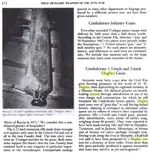There has been endless debate and disagreement about that version 2-inch-ish caliber projectile ever since the first ones showed up in the Oconee river in GA.
Note, the lack of an expanding base or sabot means it was made for use in a Breechloader cannon -- and Breechloader cannons were VERY rare in the civil war. And, ESPECIALLY rare for the Confederates to possess (except for a few imported British rifled-cannons, like the Whitworth).
For these little 2"-ish bolts with lead body-bands to be civil war era (and especially, to be Confederate), you/we MUST prove the simultaneous existence of a corresponding cannon which used them as ammunition. One "promoter" of the idea that it is a civil war CSA breechloading projectile points to a report that a small-caliber Breechloading Rifled Cannon was made at the Georgia Railroad's machining shop, from an old railroad-car axle. But there's no mention of that cannon's caliber. The so-called Sumner Oscillating Breechloading Cannon has also been mentioned, but again, there seems to be no record of that cannon's caliber (bore-diameter). Therefore, though all of the 30 years or so since these little bolts first appeared, I have declined to put my stamp-of-approval on them as being a civil war artillery projectile. (And of course, I have steadfastly declined to buy or sell any of them.)
It's worth mentioning that a fair amount of post-civil-war (1870s-through-90s) Ordnance has been found dumped at the same spot at the river where these bolts are found. For example, US .45-70 caliber Model 1873 "Government" Rifle unfired ammunition, and unused US Model-1896 Radial Vent artillery friction-primers. Therefore, the possibility that these little bolts are for a postwar breechloader must be given full weight in the time-dating analysis of the bolts.






